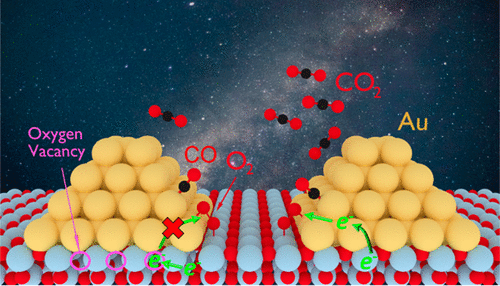当前位置:
X-MOL 学术
›
J. Am. Chem. Soc.
›
论文详情
Our official English website, www.x-mol.net, welcomes your
feedback! (Note: you will need to create a separate account there.)
Manipulating Atomic Structures at Au/TiO2 Interface for O2 Activation
Journal of the American Chemical Society ( IF 14.4 ) Pub Date : 2020-03-23 , DOI: 10.1021/jacs.9b13453 Jiawei Huang 1 , Shuai He 1 , Justin L. Goodsell 1 , Justin R. Mulcahy 1 , Wenxiao Guo 1 , Alexander Angerhofer 1 , Wei David Wei 1
Journal of the American Chemical Society ( IF 14.4 ) Pub Date : 2020-03-23 , DOI: 10.1021/jacs.9b13453 Jiawei Huang 1 , Shuai He 1 , Justin L. Goodsell 1 , Justin R. Mulcahy 1 , Wenxiao Guo 1 , Alexander Angerhofer 1 , Wei David Wei 1
Affiliation

|
Metal/oxide interface has been extensively studied due to its importance for heterogeneous catalysis. However, the exact role of interfacial atomic structures in governing catalytic processes still remains elusive. Herein, we demonstrate how the manipulation of atomic structures at Au/TiO2 interface significantly alters the interfacial electron distribution and prompts O2 activation. It is discovered that at the defect-free Au/TiO2 interface, electrons transfer from Ti3+ species into Au nanoparticles (NPs) and further migrate into adsorbed perimeter O2 molecules (i.e., in the form of Au-O-O-Ti), facilitating O2 activation and leading to a 34 times higher CO oxidation activity than that on the oxygen vacancy (Vo)-rich Au/TiO2 interface, at which electrons from Ti3+ species are trapped by interfacial Vo on TiO2 and hardly interact with perimeter O2 molecules. We further reveal that the calcination releases those trapped electrons from interfacial Vo to facilitate O2 activation. Collectively, our results establish an atomic-level description of the underlying mechanism regulating met-al/oxide interfaces for the optimization of heterogeneous catalysis.
中文翻译:

操纵 Au/TiO2 界面的原子结构以激活 O2
金属/氧化物界面因其对多相催化的重要性而被广泛研究。然而,界面原子结构在控制催化过程中的确切作用仍然难以捉摸。在此,我们展示了 Au/TiO2 界面处原子结构的操纵如何显着改变界面电子分布并促进 O2 活化。发现在无缺陷的 Au/TiO2 界面,电子从 Ti3+ 物质转移到 Au 纳米颗粒(NPs)并进一步迁移到吸附的周边 O2 分子(即以 Au-OO-Ti 的形式),促进 O2 活化导致 CO 氧化活性比富氧空位 (Vo) 的 Au/TiO2 界面高 34 倍,来自 Ti3+ 物种的电子被 TiO2 上的界面 Vo 捕获并且几乎不与周边的 O2 分子相互作用。我们进一步揭示了煅烧从界面 Vo 释放那些被捕获的电子以促进 O2 活化。总的来说,我们的结果建立了对调节金属/氧化物界面以优化多相催化的潜在机制的原子级描述。
更新日期:2020-03-23
中文翻译:

操纵 Au/TiO2 界面的原子结构以激活 O2
金属/氧化物界面因其对多相催化的重要性而被广泛研究。然而,界面原子结构在控制催化过程中的确切作用仍然难以捉摸。在此,我们展示了 Au/TiO2 界面处原子结构的操纵如何显着改变界面电子分布并促进 O2 活化。发现在无缺陷的 Au/TiO2 界面,电子从 Ti3+ 物质转移到 Au 纳米颗粒(NPs)并进一步迁移到吸附的周边 O2 分子(即以 Au-OO-Ti 的形式),促进 O2 活化导致 CO 氧化活性比富氧空位 (Vo) 的 Au/TiO2 界面高 34 倍,来自 Ti3+ 物种的电子被 TiO2 上的界面 Vo 捕获并且几乎不与周边的 O2 分子相互作用。我们进一步揭示了煅烧从界面 Vo 释放那些被捕获的电子以促进 O2 活化。总的来说,我们的结果建立了对调节金属/氧化物界面以优化多相催化的潜在机制的原子级描述。


















































 京公网安备 11010802027423号
京公网安备 11010802027423号